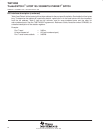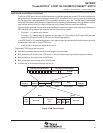
TNETX4090
ThunderSWITCH II
9-PORT 100-/1000-MBIT/S ETHERNET
SWITCH
SPWS044E – DECEMBER 1997 – REVISED AUGUST 1999
30
POST OFFICE BOX 655303 • DALLAS, TEXAS 75265
frame format on the NM port (continued)
Any device reading frames out of the NM port must expect frames to be in the format shown in Figure 2.
Frames received into the switch on the NM port also must conform to this format, with the following caveats:
crc = 0
in
NMRxControl
When the host is providing a frame containing valid CRC it also must provide in the TPID field valid header
parity protection and indicate via the crctype bit which type of CRC the frame contains [i.e., including the
header (crctype = 0), or excluding the header (crctype = 1)]. If crctype indicates that the header is included,
as for NM port transmissions, this mimics the presence of IEEE Std 802.1Q TPID of 81–00 (ethertype
constant) in the TPID field. If a CRC error or parity error is detected, the frame is discarded.
When
crctype indicates that the header is included, the NM port regenerates CRC to exclude the header
during the reception process (this converts the frame into the required internal frame format).
crc = 1
in
NMRxControl
If the switch is being asked to generate a CRC word for the frame, the values in the TPID field are ignored by
the NM port. The switch inserts header parity protection. It replaces the final four bytes of the frame with the
calculated CRC (the values in the final four bytes provided are don’t care).
In either case, the NM port inserts its own port number into the source port field in the least significant bits of
the first TPID byte, sets the crctype bit to 0, and also sets the reserved bits to 0.
Frames received from the host via the NM port are required to contain a valid IEEE Std 802.1Q VLAN ID in the
third and fourth bytes, following the source address (the NM port does not have a PortxQTag register for
inserting a VLAN tag if none is provided and does not have an
rxacc bit). Frames that do not contain a VLAN
tag are incorrectly routed. They also can be corrupted at the transmission port(s). The header-stripping process
does not check that the two bytes after the source address are a valid IEEE Std 802.1Q TPID because there
is a valid header under all other circumstances.
When a frame is transmitted on the NM port, no header stripping occurs (again because the NM port does not
have a PortxQTag register or
txacc bit), so the frame read by the host software contains one header (or possibly
more, depending on how the frame was received).
In either case, the NM port inserts its own port number into the source port field in the least significant bits of
the first TPID byte and sets the reserved bits to 0. Frames received from the host via the NM port are required
to contain a valid IEEE Std 802.1Q VLAN ID (VID) in the third and fourth bytes following the source address.
(The NM port does not have a default VLAN ID register for inserting a VLAN tag if none is provided. It cannot
also be configured as an access port.) Frames that do not contain a valid tag are incorrectly routed. They also
can be corrupted at the transmission port(s) as the tag-stripping process does not check that the four bytes after
the source address are a valid tag because they are valid tags under all other circumstances.
When a frame is transmitted on (read from) the NM port, no tag stripping occurs (because the NM port does
not have the default VLAN ID register or access configuration control), so the frame read by the host software
can contain one or more header tags, depending on how the frame was received.


















